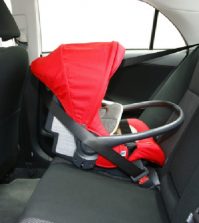- Study Says Most Parents Don’t Use Car Seats In Ride Share Vehicles Like Uber
- This 12-Year-Old Boy Is A Sophomore Aerospace Engineering Major!
- Fire Safety Experts Warn Of Hand Sanitizer Danger After A Mom and Kids Escape House Fire
- Recall Alert: Peaches May Be The Cause Of Salmonella Outbreak, 68 People Ill
- Summer Vacation In The Days Of COVID: Tips To Stay Safe
- How To Safely Grocery Shop During The Coronavirus Pandemic
- Michigan Teen With Vape-Related Illness Undergoes Double Lung Transplant
- Teen Kicks Off Anti-Vaping Campaign From Hospital Bed
- Teenager Receives Life Sentence For Strangling Sister To Death Over A Wi-Fi Password
- Toddler Falls To Death From 11th Deck of Cruise Ship
Toddler Dies After Swallowing Button-Sized Battery


It’s hard to imagine that something as tiny as a button could kill your child.
But that’s exactly what happened to one Oklahoma toddler after she ingested a small, coin-sized battery.
Family members of little Brianna Florer — who were unaware she had swallowed the the battery in the first place — say there were no warning signs she was in serious distress until it was too late. On Dec. 27, Brianna was rushed to a hospital shortly after she started throwing up large amounts of blood. An X-ray revealed she had swallowed a battery the size of a nickel.
“They operated on her for 2½ hours, but they couldn’t stop the bleeding,” her grandfather, Kent Vice, told Fox8News. “They believed the battery ate through to her carotid artery by way of her esophagus.”
Little Brianna died just three days after Christmas.
According to the National Capital Poison Center (NCPC) in Washington, D.C., there were a total of 11,940 battery-swallowing incidents nationwide between 2005 and 2014 that involved children younger than 6. Of these incidents, 101 children experienced major medical problems and 15 children died.
Although a button battery can pass through the digestive system, serious trouble begins if it becomes lodged in the esophagus or digestive tract. The battery can actually open and release an alkaline substance that causes burning injuries. Electrical current can also to go through the tissue, wreaking even more havoc.
“The electrical current is causing more damage because it is splitting the water surrounding the button battery and forming hydroxide, which is an ingredient in lye. Imagine dropping little tiny drops of lye in one place in the esophagus,” Dr. Toby Litovitz, an NCPC physician, told NewsOK.
This lye substance perforates a child’s esophagus and enters tissue nearby, whether it’s the trachea or the aorta, Litovitz explained. Severe complications have also been observed when small batteries are lodged in the nose or ear, he noted.
Unfortunately, these button-sized batteries can be found in most homes. Some common products that use them include: Remote controls, watches, cameras, calculators, digital thermometers, hearing aids, toys,, handheld video games, bathroom scales, garage door openers, talking books, singing greeting cards, toothbrushes, flashing shoes and more.
A few safety tips that parents to keep in mind, as provided by the National Capital Poison Center, can make the difference between life and death:
- Never leave batteries out. Store batteries out of sight and and out of reach of young children. If recycling is not possible, wrap used batteries securely and discard them where a child can’t find them.
- Check all household devices battery compartments are secured shut. Strong tape to secure in order for children to not open the device. Purchase devices that use a screwdriver to open or have a child-resistant mechanism.
- Batteries are in most products, check:
- remote control
- garage door remotes
- keyless fobs
- scales
- kidsoys
- cameras
- watches
- calculators
- digital thermometers
- hearing aids
- greeting cards
- talking books
- stereos
- handheld video games
- medical equipment
- flash lights
- flashing kids shoes
- toothbrushes
- keychains
- Be cautious with any product that contains a battery that is as big as a penny or larger.
- The 20 mm diameter lithium cell is most serious problem
- They can be recognized by their engravings with these 3 codes: CR2032, CR2025, CR2016.
- Do not allow a child to play with batteries or battery powered devices that the battery is easily accessible.
- Make sure all hearing aids for children have child-resistant battery compartments.
- Inform family who wear hearing aids to the importance of keeping the batteries out of reach of small children.
- Don’t change batteries in front of a child.
If a Battery is Swallowed or Placed in the Ear or Nose:
- Call the National Battery Ingestion Hotline at +12026253333 immediately.
- If the battery was swallowed, do not eat or drink until an x-ray shows the battery is beyond the esophagus. A battery stuck in the esophagus can cause severe damage within just 2 hours.
- If the battery was placed in the nose or ear it must be immediately removed.








Tom Nancy Peterie
May 21, 2016 at 1:37 am
Tristen Long Lorielleelle Jason Peterie Matt PeterieMichelle Michelle Peterie Soupir
Jamie Rekus
May 21, 2016 at 2:31 pm
I went to legoland and my husband found one in the Lego bins the kids play in. I made him take it to security. Hope it was a mistake but I find it odd someone would lose a batterie there .